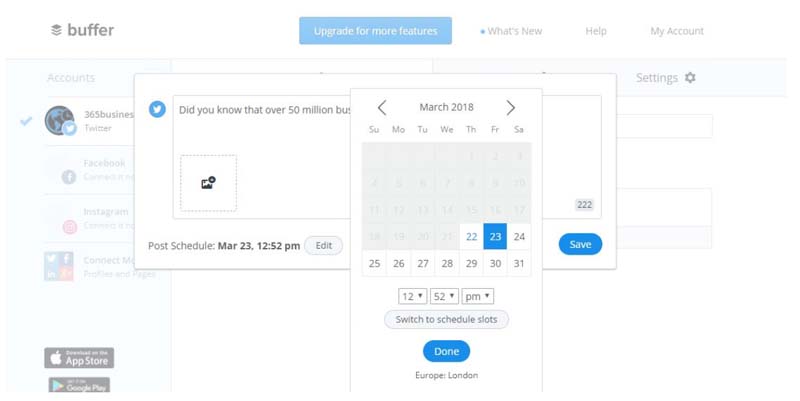Contributed by: Sophia Conti
Businesses always feel pressure to do more with social media, whether it’s getting on a new platform, increasing followers, or developing new content. This is for good reason because the majority of consumers are on some form of social media. It serves as a primary way for them to gather information. Social media marketing has been proven to increase sales and brand exposure.
Social media management seems like an insurmountable hurdle at first. How can one small business build a vibrant and effective presence on so many channels, while still maintaining all the other elements of a business?
Luckily, there are many tools and resources available to help with your social media managment and make the biggest difference with limited time. Spending as little as four hours a week on social media marketing can still have a huge effect on your small business.
Why Social Media?
Small businesses often jump into social media management because they feel like they have to. To remain competitive, businesses must be where their competitors and consumers are, and that’s almost always on social media. But creating social media accounts with no clear plan or purpose will only lead to frustration and a poor return on investment.
To understand more about the world of social media, check out some of these sites and blogs. They provide basic information on starting a social media strategy and publishing new information on changes, trends, and best practices in the social media world:
- Social Media Impact
- Social Media Examiner
- Best Practices from Moz
Not all social media goals are easily measured, so it’s important to know what you can measure, what you can’t, and what your business needs or wants to focus on. Below are some sites that focus on social media best practices and have an active blog or resource center.
Establish Brand Voice
Your brand personality shines through your social media profiles. Because business social media profiles interact with actual people, it has to have a consistent personality that takes on some human-like traits. Many national brands, such as Taco Bell and Netflix, have gained notoriety for their distinct brand voices. They are particularly sarcastic, funny, or reliant on memes and other cultural content to engage with followers.
Brand voice must reflect company values and mission. Is your business educational, informative, or political? Is it more important to be funny or to be nurturing? All content across all channels must reflect these values, in visual and written content.
For example, Renovate America, an energy efficiency financing provider, shares a lot of informational content about homes and energy efficiency. At the same time, it emphasizes the importance of family in their visual content, as you can see from their Instagram page:
The visual focus on families and pets will draw in their target audience: The homeowners who may be looking to save money.
Before posting anything on social, take time to determine what your brand voice will be. Are you funny, informational, or political? Do you chime in on trending news topics, or stick to brand and industry-related content? Will you share content from other businesses and influencers, or just your own?
Here are some articles and resources on establishing a brand voice:
- 20 Great Social Media Voices (And How to Develop Your Own) from MarketingLand
- How to Create Your Tone of Voice for Social Media from ImpulseCreative
- 7 Powerful Ways to Build Your Social Media Brand from Entrepreneur
Brand voice is not something that can be quantified and measured. However, it can and should be monitored to maintain consistency and attract customers.
Generate Leads
Of course, any social media management tactic hopes to attract leads and convert them to customers. Simply having a social media presence and attracting followers will generate some leads – followers who like or retweet content share it with their networks, and brand awareness grows. There are many tactics and strategies businesses of all sizes can implement to generate leads, such as offering exclusive deals and discounts, conducting a poll or survey, and following trending hashtags.
For example, sneaker-selling website Kicks Deals offers a coupon to their Twitter followers:
Notice how this tweet includes a picture of the product, details of the deal, a coupon code, and a link to where they can purchase the shoes. Including all of these elements increases the chance of a lead converting from a social media post.
Here are more ideas for generating leads on social media:
- 7 Ways to Generate Leads on Social Media from Marketo
- How to Generate Leads from Social Media from ThriveHive
- 3 Foolproof Ways to Generate Leads with Social Media from Convince and Convert
Depending on the tactic, tracking leads and conversions from social media can be tricky. Specific campaigns asking users to sign up for a newsletter or enter their email for a coupon code are easier to track. They also may be safer practices if measuring ROI is a priority. Those with more time and inclination to track social media leads and conversions in detail can try their hand at more advanced analytic tools.
- A Beginner’s Guide to Lead Conversion with Social Media from Kissmetrics
- How to Measure Your Social Media Lead Generation Efforts from Hubspot
- How to Measure Social Media Lead Generation by Channel from Salesforce (advanced)
Engage with Customers
The power of social media management comes from the ability to easily and immediately interact with customers and leads. Social media is a part of customer service and encourages sales. It’s an easy way to connect with customers who may be far away.
Airlines are particularly well-known for using social media as a form of customer service, like in this example from American Airlines:
Customer engagement is one of the easiest attributes to measure. This is because it takes the form of likes, replies, or shares that are immediately visible on every post. Engagement helps determine what content performs well. Many channels have built-in analytics that can provide a more in-depth view of these interactions.
Interacting with customers and fostering engagement is pretty straightforward. It does require some forethought though. You need to ensure consistency with the established brand voice and among anyone within the business who interacts with customers.
Here are some resources and guidelines on customer interaction best practices:
- 10 Tips for Increasing Social Media Engagement from Social Media Week
- 5 Best Practices for Social Media Customer Engagement from Rival IQ
Social Media Management
Knowing these tactics is one thing, but implementing them well is quite another. Busy small business owners don’t have the time or resources to spend hours a day replying to tweets and creating content for each social platform. Thankfully, there are several ways to dedicate just a few hours a week to social media marketing and still yield excellent results.
Identify Key Social Platforms
Not all businesses need to be on all platforms. Understand the target audience and what social platforms they are most likely to use, and focus on those. Twitter is pretty much a given for all brands (except perhaps local ones). Facebook and Instagram are also essential for B2C companies. Trying to establish a presence on every social platform will only lead to frustration and wasted time.
Here are some resources for identifying the best social platforms:
- Determining Which Social Media Platforms to Focus On from Business.com
- Which Social Media Platforms Are Best for Your Business? from The Next Web
- How to Find the Most Profitable Platform for Your Business from Neil Patel
Driving traffic to your website may be the focus of your social media management efforts. That’s okay, but your website should still include links to your social media profiles. This way, leads who find your website through other means can remain engaged with your brand on social media. Buttons for social media platforms can easily be incorporated into a header or footer, like in this example from VitaMedica:
Create and Automate Your Posting Schedule
With automated posting tools – many of which are free – you can spend just a few hours a week creating and scheduling social media posts. Then, let them self-publish throughout the week. This is an easy way to test the timing and frequency of posting without having to remember to post at certain intervals.
In a social media management software like Buffer, simply write a post and add it to the queue at the time you choose. You can then organize and modify the queue as necessary.
Integrate your blog calendar with your social media calendar to ensure a constant supply of content ideas. Ask questions to engage with followers, or keep up with trending topics and holidays. Content can be duplicated across platforms, so one post idea covers all social channels.
Here are some tools and tips for automating social media posts. The software companies included also have blogs or resource centers with more content on social media marketing.
- Hootsuite
- Zoho Social
- SproutSocial
Analytics
Analytics might be intimidating, but it’s necessary to measure goals. It will help you see how many followers you’ve gained. It will also show you how many interactions your content had and how many people saw your content. Even if they didn’t interact with it, you’ll know they saw it. Many social media platforms, such as Twitter, have built-in analytics, and management software will provide analysis as well.
In this example from Twitter, you can see the number of times tweets were seen (impressions). You can see the profile visits, and mentions, as well as how those numbers have fluctuated over the last 28 days.
Software is available specifically for social media analysis. Small businesses usually do not need more than what is freely available. For more on social media analysis, check out these resources:
- Social Media Analytics Tools from Social Media Data
- Social Media Reporting Tips from Simply Measured
Starting your social media management campaign can be intimidating at first. There is no shortage of assistance available, though. Small business owners who are determined to secure their place in the social media world can easily get there. Take the time to understand social media before embarking on a strategy. This way, you can ensure purpose and clarity in achieving your goals. Then, use some of the tools and practices to spend just a couple hours a week dedicated to social media. Finally, watch the impact it has.
About the Author: Sophia Conti is a contributing editor at 365 Business Tips, a new blog that curates the best ideas and information for small business owners. She specializes in helping businesses streamline their processes and procedures.











